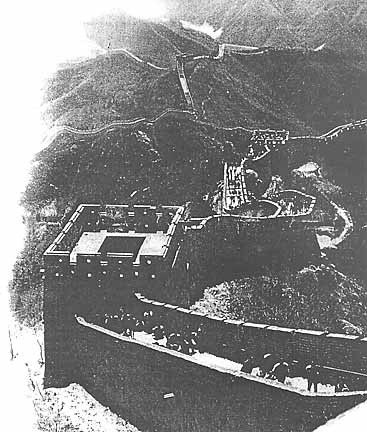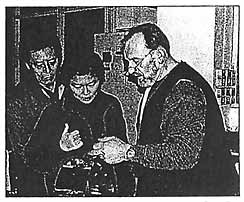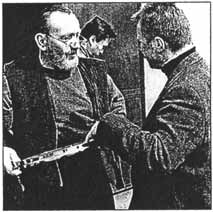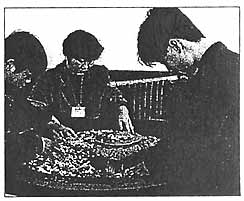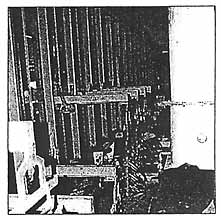|
They spread a lot of rumors like 'Sonor is bankrupt' and 'Sonor isn't manufacturing anymore.' None of that ever happened."
Far from it. Sonor is currently celebrating their 125th anniversary with an increasingly bright outlook. "In 1999, we sold more drumsets than ever before," Karl stresses. "And we expect to sell 35% to 40% more in 2000. Our competitors have had to spend the last couple of years explaining why we're still here."
Across the conference table, Muse Liu clearly enjoys this irony. An assistant manager of JMT's parent company and Karl's chief liaison in China, she is partly responsible for those impressive numbers.
Unfortunately, Sonor's rebound hasn't stopped the rumors. "Lately they've been saying, 'Sonor's production in Germany has closed down because they manufacture everything in China," Karl resumes with obvious irritation. "This is also not true. Only the Force 2001 and 3001 series are manufactured in China. Everything else is still made in Germany. And since we began our operation in the Far East, we've actually increased drumset production at our plant in Germany."
What is fueling Sonor's resurgence? For one thing, they've found their footing in a ring they'd once avoided, the red-hot—and hotly competitive-lower end of the drumset market. Perhaps because Sonor and "entry-level" had previously belonged to different universes, their first step into that ring had been a little shaky.
"The original Force 2000s weren't at the perfect price point," Karl concedes. "When we established that series in the mid-'80s, all of the drums were made in Germany." For a while, the 3000, Custom, and Maple Custom lines kept it alive. But manufacturing costs in Germany continued to rise, and we took Force off the market because it was too expensive."
That experience taught Sorter that the only way to level the playing field within this market segment was to venture beyond their home turf. At the end of 1997, they formed a partnership with JMT Musical Instrument Company, a manufacturer of many brands of musical instruments and accessories sold worldwide. Then they moved all the Force molds and tooling to China. Going offshore allowed them to resume manufacturing the series the following year-but at a much lower cost.
Karl sees Sonor's arrangement with JM (as he and the other Germans abbreviate the company's name) sign of modern economic realities. "If you look around to other industries-cars, financing, banks, pharmaceuticals—they're all merging to become bigger and more powerful worldwide," he observes. "That's what we have done. JM is part of the KHS Group, a big company — a strong company - with facilities around the world. We are prepared for the future now."
"Prepared" may be an understatement. Sonor's market share has already grown, and they exude a confidence the industry hasn't seen from them in years. "We budgeted for producing a very large number of drumsets in 2000-and we will reach it," Karl asserts. "We're optimistic about growth because this is the first time Sonor is really working to establish itself in the competitive price range. But budgeting for strong sales isn't based upon my enthusiasm. We have distribution partners all over the world. Each of them gives us a budget for the year, based upon their estimates of sales. For the 2001 and 3001 series, their budgets jumped up like crazy.
If Sonor's immediate prospects seem bright, the horizon could be positively blinding. Karl reminds me of China's billion-plus population. "Sooner or later the Chinese market will be open," he says. "When that happens, Sonor will already be here. We chose JM based upon the quality of the company not the country they are in. But fortunately for us, they are in China."
|
|
|
Chinese Address,
German Soul
Though built in China, Sonor's 2001 and 3001 lines' character remains essentially German. Literally and figuratively, this is by design; everything Sonor makes is first devised, planned, and developed in Germany.
But this kind of imprinting doesn't stop at the drawing board. Sonor ensures that its ideals (some would say obsession) regarding workmanship are maintained through vigilant oversight by Karl, Muse, and German reps like Rolf Lukowitz, one of four Sonor quality managers from Germany who oversee the Tianjin operation on a rotating basis. A big, barrel-chested man with a deep, bass voice, Lukowitz is known to everyone at the plant as Lucky (pronounced LEW-kie) or Mr. Lucky.
"I am here for the fifth time in two years," says Lucky, who has worked at Sorter for three decades. "I spend so much time here, I'm practically Chinese now," he adds sardonically in a thick German accent.
Before Sonor ventured east, JMT had already been OEMing drumsets for several budget-level brands. That experience was a mixed blessing for Sonor, since JM's standards and procedures weren't initially compatible with Sonor's.
"It took a little time to understand each other," Karl explains. "We have different ways of thinking, different ways of working."
One early challenge was China's traditional reliance on standardization, which enhances economy, but sometimes fosters resistance to modify old designs and manufacturing procedures.
"At one time we discussed the position of a bolt on the hi-hat stand," Karl remembers. "I wanted to change it, and the factory managers told me it wasn't possible. The discussion went on forever. 'No, we've done it this way for many years,' they told us, 'and we should keep doing it this way.' For them, the change seemed like just a difference in philosophy. For us, it was a matter of practicality-it was clearly a better design. Eventually they agreed to change it."
"Ja, so much of the time we were opposite," Lucky agrees, and several of JM's Chinese managers laugh knowingly.
"Sometimes we have opposition," Muse confirms in the present tense. "But Mr. Lucky makes my job easy. If someone asks why we do something, I just tell them, 'Mr. Lucky says that's how we do it.' With Mr. Lucky and issues of quality, there's no gray—only black & white."
Sonor's quality mantra takes on physical form in the Tianjin factory, where quality-control specialists closely examine every component. For example, in one corner of the plant I watched two workers check tom-holder castings. They used marker pens to circle flaws that I could barely see. Marked parts were placed in reject bins. Other workers are just as fastidious with Sonor's drum finishes. Anyone entering the lacquer finishing area must first remove their shoes and enter a "clean-room" cubicle where any dust is blown from their clothes and hair.
Examining the freshly made shells, Karl recollects, "When Lucky was here the first time, there were always problems. They didn't get the seams right."
"But now look at them," Lucky interjects. He holds up a tom shell for my inspection and enthuses, "Inside and out, you can barely see the seam. They're perfect-perfect." (This guy clearly has a passion for perfection.) "And this is a 2001," he exclaims, "the least-expensive series Sonor makes!"
Sonor's quality reflects the special training given to JM's Sonor workers, as well as the high standards Sonor sets for their wares. But while high quality has long been ingrained in Sonor's corporate culture, the pressure to keep it high was especially strong with their two Force series.
"When we made the decision to cooperate with a Chinese company, the whole world was watching," Karl comments. "We have a strong name to lose if we don't live up to our reputation. So we had to be very careful about what we do here. We had to establish a different quality standard, and we had to do it immediately. The first impression, if it's a bad one, can kill you. But our team here learned very quickly. And now they have a similar vision."
The New Force
In Drums
Sonor produced about six thousand drumsets in Tianjin during their first year. But after they had made another six thousand, management had to make a decision about the hardware molds, which degrade after time and use. Recognizing that they had to build new molds for the series anyway, they decided to redesign the line.
Along with many minor upgrades, the second generation of Force drums included smaller lugs, ball & socket tom holders, and prism clamps on tom brackets and bass drum spurs. Karl explains, "The original tom mount design functioned perfectly, and people really liked it. But these days, drummers prefer low-mass hardware that's easy to use."
Another reason for the Force redesign was Sonor products' identity and brand recognition by the public. "During the last four or five years, Sonor had too many different 'faces'," Karl admits. "We used to have the Force face, the Sonor Class face, the S-Class face, and the Designer face. All of them were completely different, and people got confused. I think it's very important for Sonor to have the same face—or very similar faces on all the lines, from the bottom to the top.
"We may continue to upgrade the hardware," he continues, "but we won't totally change the mechanics. All the current hardware fits together, even with the old Signature and Sonic series. This is a big advantage for the consumer who may be interchanging parts, and for the dealer who is stocking them."
Industry Standard
Sonor's Force 2001 and 3001 drumsets are actually made in two different plants. One handles wood-shell construction, edge cutting, sanding, drilling, finishing, and assembly. JM's metalworks factory is at a separate four-acre site approximately thirty minutes away from the main manufacturing complex. (For environmental reasons, the government restricts electroplating operations to certain districts.) The processes performed there include die-casting, processing (drilling, threading, etc.), preparation (buffing, vibration polishing), and plating.
Both facilities are clean, efficient, and completely modern. Karl tells me that the state-of-the-art shell presses in Tianjin form the shells more efficiently than the ones in Germany. And most of the diecasting is done on new vacuum die-casting machinery, the industry's technical standard. Muse explains that vacuum eliminates air pockets in the molds as the metal is injected, ensuring stronger, higher-quality parts. It also reduces the burrs and other distortions common to less advanced types of casting.
Many of the smaller metal parts are polished in high-tech vibration polishing machines, where water and thousands of different-sized ceramic "cones" find their way into the parts' holes and crevices.
Then JMT's electrolytic plating machines, also state-of-the-art, apply copper, nickel, and finally chrome plating to much of the Force series' hardware.
"Most of the manufacturing equipment is brand-new," says Karl. "Some of it is made right here at JM. Some of it comes from other countries. There are even some American-made computer-controlled machines that cost millions of dollars." Even for their lower-cost products, Sonor clearly spared no expense on manufacturing equipment.
What's In A Name?
In recent years two other companies known for premium quality drums created secondary lines, then gave them distinct brand names. This marketing strategy insulates the upper-level product's identity from the lower level newcomer. Sonor took the opposite tack.
"The Sonor name is already very respected in the world market," says Karl. "We considered the other approach, giving the drums a different brand name, but realized we didn't need to do that. We said, 'Hey, this is a Sonor product.' We created it, we developed it. And then we made it happen with our partners at JM.
"We were absolutely sure that in a very short period we would reach the quality standard that the Sonor brand represents. And if you already have positive brand recognition, in terms of marketing it's always easier to come from the top to the bottom than to come from the bottom to the top.
"Just look at the automobile industry. For years Toyota was known as a mid-priced car. When they wanted to move into higher-class cars, they were not able to push the name 'Toyota' up into that range. So they created the Lexus.
"In the drum industry, there are brands that are known solely as entry level drumsets. They will have a hard time ever reaching the top level. They don't have the image, the history, the knowledge. But with our reputation, it's easy for Sonor to present an affordable product that lives up to the Sonor name."
This article is from the July-August 2000 Issue of Drum Business, a publication for the drum industry.
|
|
